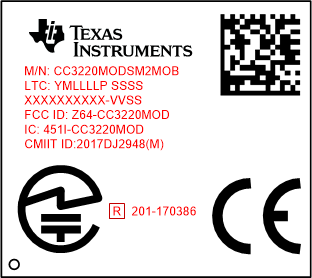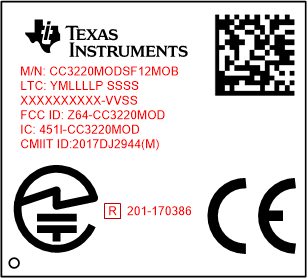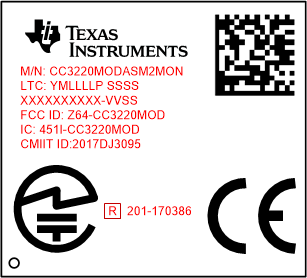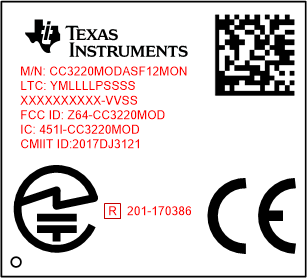ZHCSGZ7E March 2017 – May 2021 CC3220MOD , CC3220MODA
PRODUCTION DATA
- 1 特性
- 2 应用
- 3 说明
- 4 功能方框图
- 5 Revision History
- 6 Device Comparison
- 7 Terminal Configuration and Functions
-
8 Specifications
- 8.1 Absolute Maximum Ratings
- 8.2 ESD Ratings
- 8.3 Recommended Operating Conditions
- 8.4 Current Consumption (CC3220MODS and CC3220MODAS)
- 8.5 Current Consumption (CC3220MODSF and CC3220MODASF)
- 8.6 TX Power and IBAT Versus TX Power Level Settings
- 8.7 Brownout and Blackout Conditions
- 8.8 Electrical Characteristics
- 8.9 CC3220MODAx Antenna Characteristics
- 8.10 WLAN Receiver Characteristics
- 8.11 WLAN Transmitter Characteristics
- 8.12 Reset Requirement
- 8.13 Thermal Resistance Characteristics for MOB and MON Packages
- 8.14
Timing and Switching Characteristics
- 8.14.1 Power-Up Sequencing
- 8.14.2 Power-Down Sequencing
- 8.14.3 Device Reset
- 8.14.4 Wake Up From Hibernate Timing
- 8.14.5 Peripherals Timing
-
9 Detailed Description
- 9.1 Overview
- 9.2 Arm® Cortex®-M4 处理器内核子系统
- 9.3 Wi-Fi® Network Processor Subsystem
- 9.4 Security
- 9.5 Power-Management Subsystem
- 9.6 Low-Power Operating Mode
- 9.7 Memory
- 9.8 Restoring Factory Default Configuration
- 9.9 Boot Modes
- 9.10 Device Certification and Qualification
- 9.11 Module Markings
- 9.12 End Product Labeling
- 9.13 Manual Information to the End User
- 10Applications, Implementation, and Layout
- 11Environmental Requirements and Specifications
- 12Device and Documentation Support
- 13Mechanical, Packaging, and Orderable Information
请参考 PDF 数据表获取器件具体的封装图。
机械数据 (封装 | 引脚)
- MON|63
散热焊盘机械数据 (封装 | 引脚)
9.11 Module Markings
Figure 9-2 and Figure 9-3 show the markings for the SimpleLink™ CC3220MODx modules.(1)
 Figure 9-2 CC3220MODS Module
Marking
Figure 9-2 CC3220MODS Module
Marking Figure 9-3 CC3220MODSF Module
Marking
Figure 9-3 CC3220MODSF Module
Marking
Figure 9-4 and Figure 9-5 show the markings for the SimpleLink™ CC3220MODAx modules.
 Figure 9-4 CC3220MODAS Module
Marking
Figure 9-4 CC3220MODAS Module
Marking Figure 9-5 CC3220MODASF Module
Marking
Figure 9-5 CC3220MODASF Module
MarkingTable 9-7 lists the CC3220MODx and CC3220MODAx module markings.
Table 9-7 Module Descriptions
| MARKING | DESCRIPTION |
|---|---|
| CC3220MODSM2MOB | Model |
| CC3220MODSF12MOB | |
| CC3220MODASM2MON | |
| CC3220MODASF12MON | |
| YMLLLLP SSSS | LTC (lot trace code):
|
| XXXXXXXXXX-VVSS | TI internal use only |
| Z64-CC3220MOD | FCC ID: single modular FCC grant ID |
| 451I-CC3220MOD | IC: single modular IC grant ID |
| 2017DJ2946(M) | CMIIT: limited modular SRRC grant ID |
| 2017DJ2944(M) | CMIIT: limited modular SRRC grant ID |
| 2017DJ3095 | CMIIT: full modular SRRC grant ID |
| 2017DJ3121 | CMIIT: full modular SRRC grant ID |
 |
MIC compliance mark |
 |
MIC ID: modular MIC grant ID |
| CE | CE compliance mark |
1. Drawings are
representative. Content or placement may vary from what is illustrated.